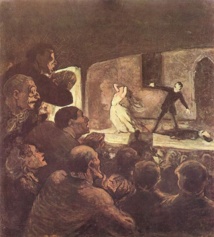
Wikicommons - Daumier
In the last two decades, melodrama and the melodramatic have been brought to mainstream scholarly attention in an effort to revisit long-standing assumptions about a much-maligned cultural form. A growing number of musicological publications—Emilio Sala’s 1995 L’opera senza canto, Jacqueline Waeber’s 2006 En musique dans le texte and Sarah Hibberd’s 2011 edited collection Melodramatic Voices—have staked the claim for melodrama’s historical importance and lasting influence. Yet the relationship between the melodramatic technique (spoken word over or alternated with instrumental music), melodramatic aesthetic (strong contrast between good and evil, extremes of emotion), and the melodramatic genre (combining the two) has remained both historically and conceptually mysterious.
In this conference, we aim to address these relationships by focussing on the period in which melodrama as a stage genre came to prominence, a period in which several of the key European traditions overlap and coincide. The earlier German, Rousseauian tradition of melodramas produced at court and at Nationaltheaters (most famously represented by Georg Benda’s Medea and Ariadne auf Naxos) continued in the form of performances of older works and the composition of new ones. At the same time, the Napoleonic period saw the emergence of the so-called “popular”, boulevard melodrama in France, often treated as a distinct entity, which was subsequently exported in translation to a number of European theatrical centres as well as to the growing cities of the United States. There were further forms of melodrama practised in this period in the Italian peninsula. Indeed, for some thirty years, melodrama in its various guises was one of the most important stage products across much of Europe. Categorisation by national tradition or division into high and low art forms has often led to the treatment of these different traditions as distinct entities. Yet in this period, the overlap of repertoire in cities and on stages, as well as obvious similarities in content and technique, suggest the fruitfulness of examining these phenomena together.
We invite proposals for papers that engage with this melodramatic moment from all disciplinary perspectives. Particular points of focus include:
· the relationship between high-art and low-art variants of melodrama
· the relationship between melodrama as genre and melodrama as aesthetic
· musical and other adaptations of exported melodramas to new surroundings
· the relationship between music and stage action (gesture, scenery, lighting)
· melodrama’s relationship to broader social and historical conditions
· the relationship between melodrama and romanticism, classicism, and the gothic
· issues of gender and identity in melodramatic performance
As it is envisaged that selected conference papers will be developed into an edited essay collection, we are asking for an abstract of 500-700 words, to be emailed to melodramaticmoment@gmail.com by Friday 15 November 2013. We aim to review applications as quickly as is reasonable and will notify applicants of our decisions by mid-December at the latest. Those invited to contribute to the symposium will be expected to send a 3000-5000 word draft of their paper for circulation to other delegates prior to the meeting. The meeting itself will include a performance workshop of representative repertoire. The conference language is English.
Katherine Hambridge (Warwick) and Jonathan Hicks (KCL)
In this conference, we aim to address these relationships by focussing on the period in which melodrama as a stage genre came to prominence, a period in which several of the key European traditions overlap and coincide. The earlier German, Rousseauian tradition of melodramas produced at court and at Nationaltheaters (most famously represented by Georg Benda’s Medea and Ariadne auf Naxos) continued in the form of performances of older works and the composition of new ones. At the same time, the Napoleonic period saw the emergence of the so-called “popular”, boulevard melodrama in France, often treated as a distinct entity, which was subsequently exported in translation to a number of European theatrical centres as well as to the growing cities of the United States. There were further forms of melodrama practised in this period in the Italian peninsula. Indeed, for some thirty years, melodrama in its various guises was one of the most important stage products across much of Europe. Categorisation by national tradition or division into high and low art forms has often led to the treatment of these different traditions as distinct entities. Yet in this period, the overlap of repertoire in cities and on stages, as well as obvious similarities in content and technique, suggest the fruitfulness of examining these phenomena together.
We invite proposals for papers that engage with this melodramatic moment from all disciplinary perspectives. Particular points of focus include:
· the relationship between high-art and low-art variants of melodrama
· the relationship between melodrama as genre and melodrama as aesthetic
· musical and other adaptations of exported melodramas to new surroundings
· the relationship between music and stage action (gesture, scenery, lighting)
· melodrama’s relationship to broader social and historical conditions
· the relationship between melodrama and romanticism, classicism, and the gothic
· issues of gender and identity in melodramatic performance
As it is envisaged that selected conference papers will be developed into an edited essay collection, we are asking for an abstract of 500-700 words, to be emailed to melodramaticmoment@gmail.com by Friday 15 November 2013. We aim to review applications as quickly as is reasonable and will notify applicants of our decisions by mid-December at the latest. Those invited to contribute to the symposium will be expected to send a 3000-5000 word draft of their paper for circulation to other delegates prior to the meeting. The meeting itself will include a performance workshop of representative repertoire. The conference language is English.
Katherine Hambridge (Warwick) and Jonathan Hicks (KCL)




